analiza naprezanja u ucvršcenju polova rotora generatora s ...
analiza naprezanja u ucvršcenju polova rotora generatora s ...
analiza naprezanja u ucvršcenju polova rotora generatora s ...
Create successful ePaper yourself
Turn your PDF publications into a flip-book with our unique Google optimized e-Paper software.
Ma{instvo 2(7), 63 – 74, (2003)<br />
N.[virig;....: ANALIZA NAPREZANJA U U^VR[^ENJU...<br />
Slika 5.9. Raspored <strong>naprezanja</strong> i reda izokroma po konturi, za model VI<br />
Figure 5.9. Stress arrangement and isochrome order along the contour for model VI<br />
6. ZAKLJU^AK<br />
Raspodjela <strong>naprezanja</strong> na kriti~nim mjestima<br />
u~vr{}enja pola <strong>generatora</strong>, bilo u obliku lastinog<br />
repa, ~eki}a ili pak njihove kombinacije, takova je<br />
iznosa da ih treba uzeti u obzir kod mehani~kih<br />
prora~una tih elemenata.<br />
Najve}i faktor koncentracije <strong>naprezanja</strong> javlja se pri<br />
modelima kod kojih je korijen pola izra|en u<br />
obliku lastinog repa ( model V ), budu}i je kod<br />
tog oblika najizra`eniji utjecaj radijusa zakrivljenosti<br />
na prijelazu tijela pola u korijen pola (sl. 5.8.).<br />
Na modelu I a posebno na modelima II – IV, faktor<br />
koncentracije <strong>naprezanja</strong> je upola manji u odnosu na<br />
model V (tablica 5.3.) {to je s jedne strane<br />
posljedica smanjenog utjecaja zareznog djelovanja<br />
(bla`i je prijelaz s tijela pola na njihov korijen), a s<br />
druge strane dosjedne povr{ine izme|u korijena pola<br />
i utora u lan~anom prstenu se pove~avaju s<br />
porastom kuta γ.<br />
Kod korijena <strong>polova</strong> u obliku ~eki}a i kombinacije<br />
~eki}-lastin rep dio <strong>naprezanja</strong> prenosio se du`<br />
vrata ~eki}a te se ukupno optere}enje ne<br />
koncentrira samo na presjek I-I (sl. 5.5.) kao pri<br />
modelu V, {to tako|er utje~e na znatno smanjenje<br />
koncentracije <strong>naprezanja</strong> na kriti~nim presjecima.<br />
Treba jo{ napomenuti da bi se dodatnim<br />
ispitivanjima trebao definirati optimalni kut nagiba γ.<br />
6. CONCLUSION<br />
Stress arrangement in critical points of the generator<br />
pole fixing, regardless of the type of fixing, i.e.<br />
swallow’s tail, hammer or their combination, are such<br />
that their values should be taken into consideration<br />
when the strength of these elements is calculated.<br />
The biggest stress concentration factor occurs with<br />
models whose pole root has the shape of the<br />
swallow’s tail (model V), since this shape shows<br />
the influence of radius roundness on the spot<br />
where pole body becomes pole root.<br />
On model I and particularly on models II – IV, stress<br />
concentration factor decreases considerably (Table<br />
5.3.) due to smaller influence of radius roundness<br />
(the transition from the body to the root is more<br />
temperate), whereas, on the other hand, the contact<br />
surface between the pole root and the groove in the<br />
chain ring increase as the angle γ increase.<br />
With pole roots in the shape of a hammer and the<br />
combination hammer-swallow’s tail, a portion of the<br />
stress is transmitted along the hammer neck and<br />
consequently, the total load is not concentrated on the<br />
cross section I – I only, (Fig. 5.5) as is the case with<br />
the model V. This also influences the stress<br />
concentration causing it to decrease at critical cross<br />
sections. It is also worth mentioning that additional<br />
tests should define optimal angle of the slope, γ.<br />
- 72 -


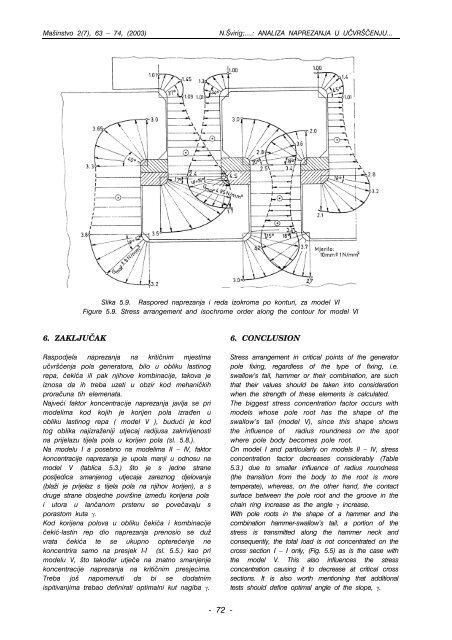
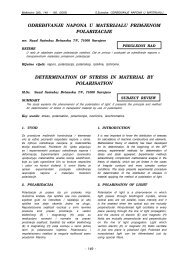
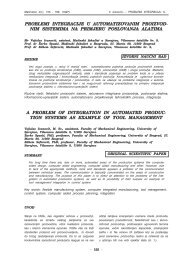

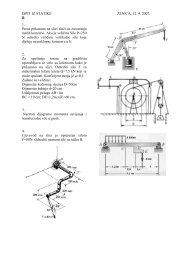
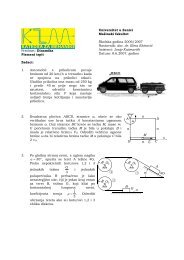
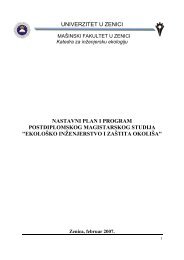
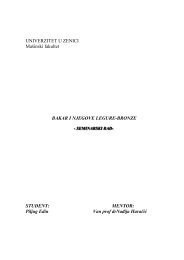
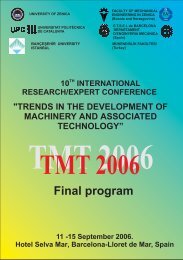
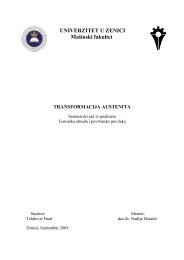
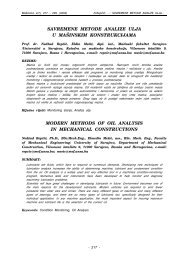
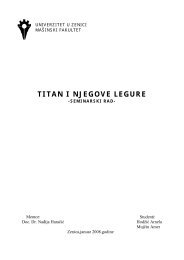
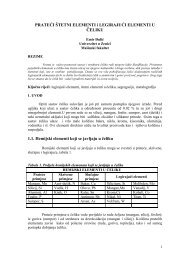
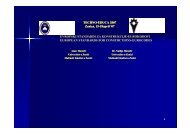
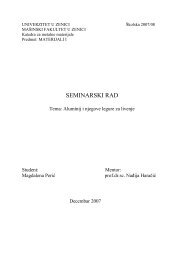
![zavarivanje kao metod produ@enja @ivotnog vijeka ku]i[ta toplotnih ...](https://img.yumpu.com/36506092/1/184x260/zavarivanje-kao-metod-produenja-ivotnog-vijeka-kuita-toplotnih-.jpg?quality=85)